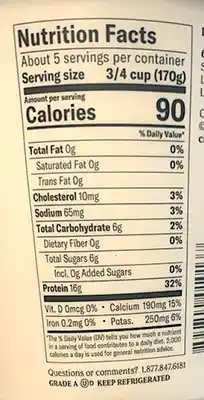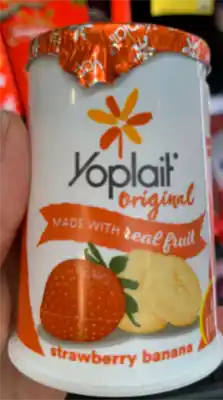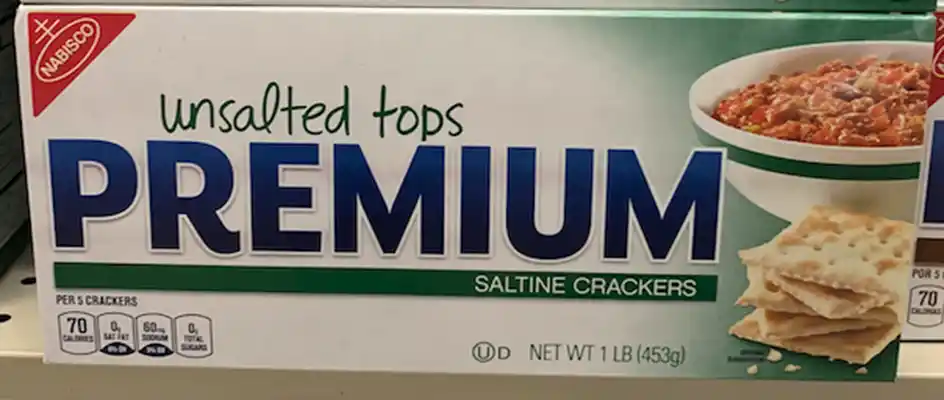
What are processed foods? What are ultra-processed foods? Let’s look at some definitions and examples for clarity, then dive into key steps to make the most educated choices as a consumer.
Processed foods are often unfairly criticized, but some processed and ultra-processed foods can be healthy, convenient, and a nutritious part of a balanced diet when chosen wisely. However, as you will see, most ultra-processed foods should be limited. Some processed foods are refined, which changes the natural form of the whole food. This lessens the fiber and other key nutrients. Additionally, ultra-processed foods may have the added drawback of containing synthetic ingredients.
Eating healthfully can feel like a complex endeavor, and choosing healthy foods in a market flooded with new choices is getting more difficult each year! Every day, the latest research, articles, posts, and reels declare new foods off-limits, stating processed or ultra-processed foods are harmful. So, let’s dive into the difference between processed and ultra-processed foods.
Article Overview
In this article, we’ll cover the following topics. Jump to a section by clicking it below.
- The evolution of processed foods
- What are processed foods
- What are ultra-processed foods
- A list of ultra-processed food ingredients to avoid
- Examples of processed and ultra-processed foods
- The best processed peanut butter
- The best processed yogurt
- The best processed bread
- The best processed crackers
- Ultra-processed foods and disease
- Ultra-processed foods and weight
- Ultra-processed foods and gut health
- How to choose less processed foods
What’s the Big Deal About Processed and Ultra-processed Foods?
Research shows consumption of ultra-processed foods may be associated with obesity, diabetes, hypertension, and colorectal cancer. (1) Even though that two-for $5 deal for your favorite highly processed snack might seem like a good deal now, the financial cost of health consequences will add up later.
We’ll dive into the health consequences of ultra-processed foods later in the article. But first, it’s helpful to understand the history of processed foods, how ultra-processed foods came to be, what they are, and how to make healthy choices around them.
A Brief History of Processing Food
Humans have been processing foods for a long time! Many foods need to be altered or cooked to make them edible, safe, or to extend shelf life. Foods may also be processed to make them more palatable, convenient, or nutritious. Modern food methods have significantly evolved, and some processing negatively affects our health! (2)
New technological advances have given us additives and food derivatives that are very different from the cooked, whole foods that were the peak of food processing for much of human history. (3) So, let’s look at the modern definitions of processed food and ultra-processed food to understand the effects they have on our health!
The Evolution of Nova, Processed Foods, and Ultra-Processed Foods

Because of all the modern changes in how food is processed, a Brazilian scientist named Carlos Monteiro and his team at the University of Sao Paulo developed a new food classification system called Nova, which has been adopted worldwide. The Nova system and how processed vs ultra-processed foods are classified have changed over time.
This classification offers insights into our food culture and system but can be challenging for the consumer to understand. The Nova classification system is a descriptive criterion that assigns foods to one of four groups based on processing-related criteria. Don’t worry; I’ll break it down for you.
Nova Group 1
These are unprocessed or minimally processed foods. Minimally processed foods have their inedible or unwanted parts removed, like shelled walnuts or rolled oats. Processes like drying or pasteurization are included in this group.
- As long as other ingredients have not been added to the food, it is Group 1.
- Some examples of Group 1 foods include fruits, vegetables, eggs, meat, pasteurized milk, etc.
Dr. Randi Wolf, PhD, MPH, a nutritional epidemiologist at Teachers College, Columbia University, says, “Group 1 can include added vitamins as preservatives. When vitamins and minerals are added to replace nutrients that may be removed during processing (like folic acid added to wheat flour) or for the purpose of preservation (like vitamin C added to pre-cut fruit), that does not make it ultra-processed.”
Nova Group 2
Group two foods are foods processed or obtained from nature for use in the kitchen. In practice, these are ingredients such as fats and oils, aromatic herbs, etc., used for cooking or seasoning Group 1 foods.
“These foods are referred to as ‘culinary ingredients’ and typically used to add flavor to Group 1 foods,” per Wolf.
Nova Group 3 (Processed foods)
Processed foods. These are the foods obtained by combining foods of groups 1 and 2 to get the many food products for domestic use (bread, jams, etc.). This group also includes canned or bottled foods with culinary ingredients added, like canned beans in brine.
Nova Group 4 (Ultra-processed foods)
Ultra-processed foods. They are the ones that use ingredients you may not recognize as food, including food additives that improve palatability.
- These ingredients often include additives derived from food constituents (hydrogenated fats, modified starches) and synthesized in laboratories (flavor enhancers, colors, etc.). They may also contain ingredients that are rarely used in home cooking, such as soy protein or mechanically separated meat.
- Because of these ingredients, we call ultra-processed foods industrial formulations.
- These foods usually include little to no whole-food ingredients. They are characterized by hyper palatability and the fact that they can be stored for a long time. (3,4)
What are Processed Foods?
Processed foods are products manufactured by the food industry and represent Group 3 on the Nova scale. As mentioned, Nova is a system that helps classify the degree to which foods have been processed.
Essentially, processed foods start as whole foods, but salt, sugar, oils, fats, or other substances have been added to make them more stable and palatable.
What Are Ultra-Processed Foods?
Ultra-processed foods (UPF) contain industrial chemical additives, which make the final product hyper-palatable. In the past, they were described as “formulations mostly of cheap industrial sources of dietary energy and nutrients plus additives, using a series of processes” and containing minimal whole foods. (5)
They represent Group 4 on the Nova scale. (3) Ultra-processed foods often have five or more ingredients but can have fewer.
- For example, an ultra-processed potato chip may contain potatoes, oil, modified food starch, and dextrin. These are just four ingredients, and you can pronounce them. But I doubt you keep modified food starch or dextrin in your kitchen. Try making homemade chips or fries in an air fryer or oven instead.
The definition of UPF is still in flux. The primary definition used in 2017 included that UPFs usually have five or more ingredients, but this was not a hard rule. The definition from 2019 did not include an ingredient count. Instead, it focused on the addition of one or more cosmetic additives.
As Nova evolves, nutrition educators like me hope they will point out which additives are associated with negative health outcomes.
The Non-UPF Program and Non-UPF Certificate Label for Front of Food Packaging
If you’re looking for a simple way to identify and choose foods that are less processed, The Non-UPF Program is here to help! This nonprofit is dedicated to reducing ultra-processed foods in American diets by providing education, advocacy, and a trusted certification that helps consumers make healthier choices with confidence. By looking for our Non-UPF Certified seal on food products, you can quickly spot options that align with a whole-food approach to eating without harmful additives for you and your family. Learn more about how this initiative is shaping the future of food and empowering consumers at www.nonupfprogram.org.

What are Cosmetic Additives?
Cosmetic additives help disguise unwanted sensory properties and make the food palatable or hyper-palatable by improving the visual appeal, texture, taste, or smell. (3,6).
Read the Ingredients to Determine Which Food is Less Processed
When comparing processed foods versus ultra-processed foods, see which has the most recognizable ingredients. If you see mostly ingredients you might use in your kitchen, this is likely the less processed choice.
- Ultra-processed foods may have more ingredients you don’t recognize or would not use when cooking.
- In addition to salt, sugar, oils, and fats, for a food to be ultra-processed, it must include one or more food substances not commonly used in culinary preparations.
- For example, hydrolyzed corn protein or potassium gluconate would not be in your kitchen cupboard. See the table of ultra-processed ingredients below for a better understanding.
List of Ultra-processed Food Ingredients
Ultra-processed foods include ingredients that are often used to disguise the final product’s undesirable qualities or to improve texture and flavor. (3) When providing nutrition counseling, I recommend limiting these in your diet. This is an abbreviated list of ultra-processed food ingredients.
The ingredients with an asterisk appear to be safe for most people, however, they are an ultra-processed ingredient which may contribute to over-eating. When comparing two products with similar nutrition facts, choose those with less ultra-processed additives.
For more information, try this resource for chemical cuisine ratings.
| Ultra-Processed Ingredient Class | Ingredients you might see on a food label (Incomplete List) |
|---|---|
| Hydrolyzed proteins | Hydrolyzed corn protein, hydrolyzed wheat gluten, hydrolyzed soy protein. (8) |
| Modified starches | Modified food starch*, Modified Corn Starch*, oxidized starch*, monostarch phosphate*, distarch phosphate*. (9) dextrose |
| Hydrogenated or Interesterified oils | Fully hydrogenated vegetable oil, Hydrogenated vegetable oil, interesterified oils. (10) |
| Colorants | Azodibcarbonamide, Carmine (Cochineal), Caramel coloring, Red, blue, or yellow dye, other synthetic food dyes, or (7) |
| Flavorings | Artificial and natural flavors, autolyzed yeast extract*, castoreum*, diacetyl, fumaric acid*, guanosine monophosphate (GMP)* disodium guanylate(7) |
| Sweeteners | Cyclamate, Invert sugar, dextrose |
| Non sugar Sweeteners | Acesulfame potassium, aspartame, saccharin, and other artificial sweeteners (7) |
| Emulsifiers | soy lecithin, sunflower lecithin, brominated vegetable oil (bvo), cellulose*, pectin*, datem*, dextrin*, mono-and diglycerides*, polyglycerol polyricinoleate (PGPR)*, polysorbate 60,65,80, sorbitan monostearate*, sucrose acetate isobutyrate* (7) |
| Anti-Foaming agents | Dimethylpolysiloxane (a type of silicone) |
| Fruit juice concentrate | Apple juice concentrate |
| Gelling and Glazing Agents | Pectin |
| Thickeners | Carrageenan, Alginate*, Gums (Arabic, guar, xanthan), |
There’s a lot of scientific language to dissect around processed vs. ultra-processed foods, even for a dietitian! How does all of that apply when you’re choosing which foods to buy at the supermarket?
- Focus on the types of ingredients when reading the ingredient list.
- Don’t stop at reading the nutrition facts panel. You’ve got this!
The food product examples below will help you better understand processed vs. ultra-processed foods.
Examples of Processed and Ultra-Processed Foods
As a dietitian, I regularly include processed foods in my healthy, well-balanced diet. These are also foods included in recommendations for my clients. For example, here are a few processed foods I include often:
- Refried beans (beans, filtered water, onions, oil, garlic, sea salt, spices)
- Marinara (Italian whole peeled tomatoes, olive oil, carrots, salt, celery, basil)
- Organic Greek yogurt (cultured pasteurized nonfat organic milk, live active cultures).
Buying these healthy processed foods in the supermarket includes the extra step of reading past the food label. Once you start reading the ingredient list, it’s easier to limit or avoid ultra-processed ingredients.
A list of processed foods might look like this:
- Staple foods like bread, peanut butter, or yogurt without additives
- Canned vegetables or beans preserved in brine or water
- Fruits preserved in syrup
- Canned fish or meats
A list of ultra-processed foods might contain the following:
- Staple foods like bread, peanut butter, or yogurt with ingredients added from the ultra-processed ingredient list.
- Candy Bars
- Cookies, cakes, and other desserts made in factories.
- Snack foods like chips or crackers
- Protein bars, protein powders, or workout supplements
Notice how there’s some overlap? If this is still confusing, the actual product examples of processed and ultra-processed foods below will help. We’ll start with peanut butter, explore bread options, and then take a look at yogurt and crackers.
Energy Intake from Ultra-Processed Foods
From 1999 to 2018, the estimated percentage of total energy from consumption of ultra-processed foods in US youth 2-19 increased from 61.4% to 67.0% (18) Among US adults in the NHANES, the estimated percentage of energy from ultra-processed foods has increased from 53.5% to 57.0% over the past two decades, with some research citing intake as high as 58%. (19) UPFs are linked with higher intake of added sugars, sodium, and unhealthful fats. (19)
In addition, as a dietitian for over twenty years, I didn’t see such a high incidence of autoimmune and food allergies when I first started counseling patients. Although not formally linked, I believe these foods are causing havoc in the intestines (your immune system activator).
Processed vs. Ultra-Processed Peanut Butter
All these peanut butter options below would be considered processed foods because they all have additives like sugars, fats, or salt. Which peanut butter(s) do you think are ultra-processed?
The ultra-processed ingredients are highlighted below.
| Jif Peanut Butter | Skippy Creamy Peanut Butter | Justin’s Honey Peanut Butter | Laura Scudder’s Old Fashioned Smooth Peanut Butter |
|---|---|---|---|
 |  |  |  |
 |  |  |  |
| Ingredients: Roasted peanuts, sugar, contains 2% or Less of: Molasses, Fully Hydrogenated Vegetable Oils (rapeseed and soybean), mono and diglycerides, salt. | Ingredients: Roasted peanuts, sugar, hydrogenated vegetable oil (cottonseed, soybean and rapeseed oil) to prevent separation, salt. | Ingredients: Dry roasted peanuts, organic honey, organic cane sugar, peanut oil, palm oil, sea salt. | Ingredients: Peanuts, contains 1% or less of salt. |
The answer is that the Skippy and Jif Peanut butter are the ultra-processed choices. That means that Justin’s and Laura Scudder’s Peanut Butter are processed foods (group 3 on the Nova classification system.) So are these the healthier choices? Well, maybe.
Processed Peanut Butter – Which to Choose?
Even though Justin’s and Laura Scudder’s peanut butter are less processed than the other two, the ingredients used in each product make all the difference.
Both recipes use whole foods (peanuts) and culinary ingredients (salt or palm oil).
- Justin’s uses palm oil as an ingredient, which is higher in saturated fat and may increase the risk of heart disease. (13) In addition, this version of Justin’s includes added sugars and fats, which is not ideal as most Americans greatly exceed the World Health Organization’s (WHO) sugar recommendations.
- Laura Scudder’s would be the healthiest option. Why? Because it’s better to choose products with ingredients closer to whole foods. This brand has only nuts and salt. If you need to sweeten your peanut butter, try adding your favorite chopped fruits or a drizzle of honey.
Processed vs. Ultra-Processed Bread
Let’s look at another example! Which breads below are processed or ultra-processed?
The ultra-processed ingredients are highlighted below.
| Oroweat 100% Whole Wheat Bread | Nature’s Own 100% Whole Wheat Bread | Oroweat Grains Almighty Gut Balance Bread | Dave’s Killer Bread Thin-Sliced 21 Whole Grains and Seeds |
|---|---|---|---|
 |  |  |  |
 |  |  |  |
| Ingredients: Whole wheat flour, water, bulgur wheat, sugar, whole wheat, vegetable oil (soybean), wheat gluten, honey, yeast, cultured wheat flour, sea salt, grain vinegar, soy lecithin, natural flavors, citric acid, soy, whey. | Ingredients: Whole wheat flour, water, yeast, brown sugar, wheat gluten, contains 2% or less of each of the following: salt, cultured wheat flour, soybean oil, vinegar, distilled monoglycerides, enzymes*, monocalcium phosphate, ascorbic acid, soy lecithin, may be topped with wheat bran. | Ingredients: Whole wheat flour, water, whole grain barley, wheat gluten, yeast, sunflower seeds, sugar, honey, inulin (chicory root powder), wheat sourdough (water, fermented wheat flour), vegetable oil (soybean, palm), flaxseed, sea salt, cellulose fiber, molasses, sprouted wheat, cultured wheat flour, sprouted rye, corn flour, soy lecithin, sprouted triticale, grain vinegar, natural flavor, cornstarch, citric acid, salt, soy, whey, sesame seeds. | Ingredients: Organic whole wheat (organic whole wheat flour, organic cracked whole wheat), water, organic cane sugar, organic 21 Whole Grains and Seeds mix (organic whole flax seeds, organic sunflower seeds, organic ground whole flax seeds, organic brown sesame seeds, organic triticale, organic pumpkin seeds, organic rolled barley, organic rolled oats, organic rolled rye, organic black sesame seeds, organic blue cornmeal, organic millet, organic rolled spelt, organic brown rice flour, organic amaranth flour, organic yellow cornmeal, organic KAMUT® khorasan wheat, organic quinoa, organic buckwheat flour, organic sorghum flour, organic poppy seeds), organic wheat gluten, organic oat fiber, contains 2% or less of each of the following: organic molasses, sea salt, yeast, organic vinegar, organic cultured wheat flour, enzymes*, organic acerola cherry powder. |
Processed Whole Grain Bread: Which to Choose?
So is an ultra-processed (Group 4) food always an unhealthy food? Is it even possible to avoid all ultra-processed food, and should we? Bread brands can be tricky to recommend as a dietitian. I’m thrilled when someone chooses 100% whole grains, so I try to give some leeway on the additives.
Overall, I recommend minimizing ultra-processed foods and strategically choosing the ultra-processed foods that can add valuable nutrition to your diet. For example, Dave’s Killer Bread is considered an ultra-processed food (Group 4 on Nova) because it contains enzymes.
Per Dr. Randi Wolf, Ph.D., MPH, “If additives such as emulsifiers or enzymes are used to enhance flavor or texture, it’s a UPF (Group 4).”
However, it is still one of the healthiest choices of breads above. It only contains one ultra-processed ingredient despite its long list of ingredients. The enzyme enhances the hedonic appeal. It’s a bread I feel good about recommending as a nutrition expert, even though it’s a Group 4 food. Also, I do include foods in my diet regularly that contain inulin.
Breads and Ultra-Processed Additives
The other brands contain more additives such as lecithin, an emulsifier, or monoglycerides and enzymes to increase the product’s sensory appeal, shelf life, and freshness. (14)
However, these are all whole-grain choices and can lower the risk of heart disease and colon cancer. They provide much-needed fiber, phytonutrients, and micronutrients. As a dietitian, I would recommend choosing the 100% whole-grain bread you enjoy the most.
Could There be Changes with Nova for Bread?
Nova is still in its infancy and has undergone many changes since it was first proposed. Perhaps there will be an exception made in the future about bread enzymes if they’re used as antioxidants.
Someday, we might see even more classes in the Nova system that draw distinctions between ultra-processed foods that can add essential nutrients to our diet and those that have very little nutritional value. But for now, this is how the Nova system classifies these foods.
Processed vs. Ultra-Processed Yogurt
Pop quiz! Look at the comparisons below and determine which foods are the least processed choices and why.
The ultra-processed ingredients are highlighted below.
| Chobani Greek Yogurt Nonfat Plain | Siggi’s Vanilla Yogurt 0% Fat | Oui by Yoplait Honey Blended Yogurt |
|---|---|---|
 |  |  |
 |   |  Calories 170 Total Fat: 8g Sat Fat: 5g Trans Fat: 0 Cholestl. 20mg Sodium: 80mg Total Carb: 21g Fiber: 0g Total Sugars: 19g (incl. 13g of added sugars) Protein 5g (unable to get a good photo) |
| Ingredients: Cultured low fat milk. | Ingredients: Pasteurized skim milk, organic agave nectar, Madagascar Bourbon Vanilla (Vanilla Extract, Vanilla Bean Specks), Fruit Pectin, active cultures | Ingredients: Pasteurized grade A milk, Cane Sugar, Organic Honey, Natural Flavors, Pectin, Yogurt Cultures, (L.Bulgaricus, S.Thermophilus) |
| Danimals Yogurt Pouches | Yoplait Originals Strawberry Banana Yogurt | Activia Vanilla Yogurt |
|---|---|---|
 |  |  |
 |  |  |
| Ingredients: Cultured Grade A Reduced Fat Milk, Sugar, Water, Modified Food Starch, Contains Less than 1% of Kosher Gelatin, Natural Flavors, Black Carrot Juice (For color) Calcium Citrate, Citric Acid, Potassium Sorbate (To maintain freshness), Vitamin D3. | Ingredients: Cultured Grade A Low Fat Milk, Sugar, Strawberries, Modified Food Starch, water, Banana Puree. Contains 1% or less of Corn Starch, Tricalcium Phosphate, Natural Flavor, Pectin, Carmine (for color), Kosher Gelatin, Vitamin A Acetate, Vitamin D3. | Ingredients: Cultured Reduced Fat Milk, Cane Sugar, Water, Modified Food Starch, Less than 1%: Natural Flavors, Modified Corn Starch, Milk Protein Concentrate, Kosher Gelatin, Agar Agar, Lactic Acid (if used as a flavor enhancer), Vitamin D3, Live Cultures L. Bulgaricus (2), L. Lactis, S. Thermophilus, Live and Active Probiotic B. Lactis DN 173-010/CNCM I-2494. |
Processed Yogurt: Which to Choose?
All of these products above are considered processed or ultra-processed food (either Group 3 or Group 4 on Nova). To turn milk into yogurt, we need some level of processing.
Per Behavioral Nutrition Scientist and Registered Dietitian Nutritionist Jen Cadenhead, PhD, RDN, ultra-processed ingredients include:
- “Any ingredient added solely to enhance the eating experience,
- an ingredient that’s not there to solely enhance the nutritive value,
- an ingredient that’s not prepared in the typical way a home/artisanal cook would use to make a product.”
“So adding pectin to yogurt to enhance the texture, likely as a thickener, would make it ultra-processed,” per Cadenhead.
However, pectin is found in certain fruits and vegetables and strengthens the cell walls. I’ve used it to make jams, and I have recommended it as a supplement for binding to heavy metals in clients with neurological diseases. So pectin, although it’s ultra-processed, is not a deterrent to me recommending a brand as a dietitian.
Ultra-Processed Yogurts
Siggi’s and Oui both contain pectin. As a dietitian, I wouldn’t hesitate to recommend Siggi’s. It’s low in sugar and a good source of calcium and probiotics, with just one additive, pectin. However, I would not recommend Oui because of the natural flavors and sugar.
There is some distinction here within the ultra-processed yogurts because Danimals, Yoplait, and Activia have more ultra-processed ingredients.
- Danimals, Yoplait, and Activia yogurt contain food starch, a type of modified starch used to increase viscosity and firmness, improve mouthfeel, and make the texture of the yogurt more appealing. (15)
- They also contain natural flavors and colors, making them firmly ultra-processed (Group 4).
- Lastly, they contain added sugar, another reason why they’re not the best choice!
Healthier Yogurt
If you’re cutting back on sugar or want to limit your ultra-processed foods (Group 4), choose plain yogurt. Then add your own sweetness with fresh fruit, dried fruit, defrosted frozen fruit, or canned fruit in its own juices.
Otherwise, opt for your favorite brand of yogurt closest to nature that has the fewest number of additives with the lowest amount of added sugar. You can also process your own yogurt at home. In addition to minimizing additives, you can reduce plastic waste. There are home yogurt kits that come in ceramic with silicone lids.
Processed vs. Ultra-Processed Crackers
Do you now understand the difference between processed and ultra-processed foods? Test your knowledge with the crackers below.
The ultra-processed ingredients are highlighted below.
| Triscuit Original Crackers | Unsalted Tops Premium Saltine Crackers | Ritz Crackers Whole Wheat | 100% Whole Grain Wheat Things Original |
|---|---|---|---|
 |  |  |  |
 |  |  |  |
| Ingredients: Whole grain wheat, canola oil, sea salt. Contains: wheat | Ingredients: Unbleached Enriched Flour (Wheat Flour, Niacin, Reduced Iron, Thiamine Mononitrate {Vitamin B1}, Riboflavin {Vitamin B2}, Folic Acid), Canola Oil, Palm Oil, Salt, Malted Barley Flour, Baking Soda, Yeast. | Ingredients: Unbleached Enriched Flour (Wheat Flour, Niacin, Reduced Iron, Thiamine Mononitrate {Vitamin B1}, Riboflavin {Vitamin B2}, Folic Acid), Canola Oil, Palm Oil, Sugar, Salt, Leavening (Calcium Phosphate, Baking Soda), High Fructose Corn Syrup, Soy Lecithin, Natural Flavor. | Ingredients: Whole Grain Wheat Flour, Canola Oil, Sugar, Cornstarch, Malt Syrup (from Corn and Barley), Salt, Refiner’s Syrup, Leavening (Calcium Phosphate and Baking Soda). |
Processed Crackers: Which to Choose?
Triscuit crackers are the best choice and a healthy processed food (Group 3 on Nova).
- They have the least number of ingredients, so it’s easy to look for ultra-processed ingredients
- No flavor or texture-enhancing additives
- They’re 100% whole grain, so they provide a fiber, micronutrient, and phytonutrient boost
Ritz crackers contain ingredients that make them ultra-processed. The other options contain refined grains or additives that increase their of saturated fat or sugar levels. They may not be considered ultra-processed, but they contribute to chronic disease.
For example, Premium Crackers’ first ingredient is white flour, a refined grain. Premium and Ritz crackers contain palm oil, which is high in saturated fat. Also, Ritz crackers and Wheat Thins contain sweeteners like sugar, high fructose corn syrup, malt syrup, and refiner’s syrup.
Crackers are not cookies! Do we really need sugar added to practically every food? We’re sweet enough.
Ultra-Processed Foods Associated with Diseases
So, how do these ingredients impact health? Your waistline isn’t the only thing at risk. Many studies have found associations between ultra-processed food and adverse health outcomes like (16):
- cardiovascular disease
- type 2 diabetes
- cancer
- cognitive decline
Additionally, those who consumed the highest amounts of ultra-processed foods were at greater risk for developing Crohn’s disease and Ulcerative Colitis. (17)
Ultra-Processed Foods Associated with Excess Weight
In the average American home, 58% of daily energy and 89% of daily added sugars come from consumption of ultra-processed food. (20,21) Many ultra-processed foods are high in calories, salt, sugar, and fat.
Now, there are a host of ultra-processed foods formulated for you to crave with their highly palatable additives that increase appetite. They are fast and easy to eat and may even quickly melt or dissolve in your mouth. These ultra-processed foods can increase your appetite (the desire to eat more), resulting in extra calories and weight gain.
In addition, many of these foods are consumed from a bag, limiting visual cues on how much you truly consumed. In studies, those who ate the most processed food tended to have higher BMIs and waist circumferences compared to those who ate the lowest amounts of ultra-processed food. High consumption of ultra-processed foods may be contributing to obesity. (1)
Limiting ultra-processed foods may be an effective strategy for obesity prevention and treatment (5) and another tool to help promote healthy weight and prevention of chronic disease.
Gut Health Negatively Impacted by Ultra-Processed Foods
One reason why ultra-processed foods may be associated with these diseases is that the sugars, sweeteners, emulsifiers, and other food additives in ultra-processed foods promote intestinal and colonic inflammation. (17) In addition, ultra-processed foods tend to be made from refined grains and low in fiber, which is incredibly important for gut health.
If you don’t have enough fiber to feed your healthy bacteria, they will feed on the mucosal lining of your intestines. This causes intestinal permeability and toxins, food particles, and bacteria to penetrate other tissues. Your gut health can, in turn, influence your cognition and mental health. (21,22)
The adage, “You are what you eat,” is true and dramatically impacts your health overall.
Misleading Food Claims on Ultra-Processed Foods
Surprisingly, some ultra-processed foods appear healthier when reading the nutrition facts, especially if you skip the ingredient list. For example, a client recently sent me images of tortillas that appeared to be healthy with the low carb and high fiber callouts on the front packaging and nutrition facts.
However, after reviewing the ingredient list, I noticed a long list of food additives. In addition, many ultra-processed foods are packaged in materials with phthalates or bisphenols. These disrupt our endocrine system and negatively impact our gut health and microbiome.
Ultra-Processed Foods May Impact Quality of Life
Per Dr. Jen Cadenhead, Ph.D., RDN, who studies human diet patterns at Teachers College, Columbia University, “Ultra-processed foods (UPF), as classified by the Nova system, are increasingly being associated with specific health outcomes.”
She and her research colleagues were curious if UPF would be related to overall health more generally. “Quality of life (QOL) is one validated marker associated with physical and mental health. QOL is also predictive of early mortality and chronic disease. Prior studies have shown associations with having a more balanced and nutritious diet with higher QOL.”
“In our study of a cohort of adults and adolescents, we also found that participant’s quality of life was associated with both having a better diet and also consuming less UPF. Greater magnitude of associations was found among adults compared with adolescents.”
What Can We Do? California Bill Processed Foods Ban
Increased awareness of food additives found in ultra-processed foods versus processed foods is growing. In 2023, California passed a new law that outlaws chemicals that are still allowed by the FDA. Red Dye No. 3, potassium bromate, brominated vegetable oil, and propylparaben are no longer allowed to be sold. These are already banned in the European Union. See how some food dyes can contribute to behavioral disturbances. However, more harmful additives continue to be developed.
How To Eat Less Processed Foods
Remember, you can eat healthier by choosing foods closer to nature with ingredients you can pronounce or might use in your kitchen. Eating closer to nature creates more energy and less day-to-day wear on your body, leading to better quality of life.
To get help with your diet and health choices, make an appointment with a registered dietitian. They’re trained in what, why, and how to eat, along with the skills to guide you to new healthy behaviors.
Knowing what to eat is a start, but learning how to change behaviors consistently that work for your unique lifestyle often requires the expert help of a registered dietitian.
How to Choose Less Processed Foods for a Healthier Life
When I counsel my clientele, I help guide them to eat more whole foods and minimize highly processed foods and beverages, especially those with artificial additives.
Over-consuming these foods displaces foods that provide essential micronutrients, phytonutrients, and fiber to prevent heart disease, cancer, diabetes, and neurological disease. In addition, a higher percentage of ultra-processed foods may be associated with cognitive decline. (23) It’s hard enough to meet all your micronutrient needs by eating a balanced diet. Even as a dietitian, I take safely evaluated supplements in a personalized amount, because I can’t meet my needs from diet alone. Although, I nail the daily fiber!
If you choose better foods, the quality of your diet will naturally improve. Now that you know the difference between ultra-processed foods and processed foods, read 10 Steps to Choose Healthy Processed Foods and Limit Ultra-Processed Foods.
Do you want a personalized nutrition plan? Book an appointment with me today. Together, we find easy solutions to build a healthier foundation over time. Take charge of your health and kickstart some results in the first six weeks: Book Nutrition Counseling.
References
- Juul, F., Martinez-Steele, E., Parekh, N., Monteiro, C. A., & Chang, V. W. (2018). Ultra-processed food consumption and excess weight among US adults. British Journal of Nutrition, 120(1), 90-100.
- (B)Welch, R. W., and P. C. Mitchell. “Food Processing: A Century of Change.” British Medical Bulletin, vol. 56, no. 1, Jan. 2000, pp. 1–17, https://doi.org/10.1258/0007142001902923.1
- (C)Monteiro, C. A., Cannon, G., Levy, R. B., Moubarac, J. C., Louzada, M. L., Rauber, F., … & Jaime, P. C. (2019). Ultra-processed foods: what they are and how to identify them. Public health nutrition, 22(5), 936-941.
- (D) Braesco, Véronique, et al. “Ultra-Processed Foods: How Functional Is the NOVA System?” European Journal of Clinical Nutrition, vol. 76, no. 9, Sept. 2022, pp. 1245–53, https://doi.org/10.1038/s41430-022-01099-1.
- Hall, Kevin D., et al. “Ultra-Processed Diets Cause Excess Calorie Intake and Weight Gain: An Inpatient Randomized Controlled Trial of Ad Libitum Food Intake.” Cell Metabolism, vol. 30, no. 1, July 2019, pp. 67-77.e3, https://doi.org/10.1016/j.cmet.2019.05.008.
- (E)Gibney, Michael J. “Ultra-Processed Foods: Definitions and Policy Issues.” Current Developments in Nutrition, vol. 3, no. 2, Feb. 2019, p. nzy077, https://doi.org/10.1093/cdn/nzy077.
- (F)“Chemical Cuisine Ratings.” Center for Science in the Public Interest, https://www.cspinet.org/page/chemical-cuisine-ratings. Accessed 25 Jan. 2024.
- (G)AskFSIS Public Q&A: What Are the Acceptable Declarations for Protein Hydrolysates That Are Made of Blends of Proteins, i.e., the Proteins from Different Sources Are Hydrolyzed Together or Individually? https://ask.usda.gov/s/article/askFSIS-Public-Q-A-prohdryo. Accessed 25 Jan. 2024.
- (H)Modified Starch – an Overview | ScienceDirect Topics. https://www.sciencedirect.com/topics/agricultural-and-biological-sciences/modified-starch. Accessed 25 Jan. 2024.
- Hydrogenated Oils – an Overview | ScienceDirect Topics. https://www.sciencedirect.com/topics/agricultural-and-biological-sciences/hydrogenated-oils. Accessed 25 Jan. 2024.
- (J) Zelman, Kathleen. Humectants and Anticaking Agents – Food & Nutrition Magazine. 30 June 2017, https://foodandnutrition.org/july-august-2017/humectants-and-anticaking-agents/.
- (K) Sequestrant (CHEBI:77963). https://www.ebi.ac.uk/chebi/searchId.do?chebiId=77963. Accessed 26 Jan. 2024.
- (L) Fattore, E., & Fanelli, R. (2013). Palm oil and palmitic acid: a review on cardiovascular effects and carcinogenicity. International journal of food sciences and nutrition, 64(5), 648-659.
- (M) List, G. R. (2015). Soybean lecithin: Food, industrial uses, and other applications. Polar lipids, 1-33.
- (N) Wong, S. S., Wicklund, R., Bridges, J., Whaley, J., & Koh, Y. B. (2020). Starch swelling behavior and texture development in stirred yogurt. Food Hydrocolloids, 98, 105274.
- (O) Elizabeth, L.; Machado, P.; Zinöcker, M.; Baker, P.; Lawrence, M. Ultra-Processed Foods and Health Outcomes: A Narrative Review. Nutrients 2020, 12, 1955. https://doi.org/10.3390/nu12071955
- (P) Lo CH, Khandpur N, Rossato SL, Lochhead P, Lopes EW, Burke KE, Richter JM, Song M, Ardisson Korat AV, Sun Q, Fung TT, Khalili H, Chan AT, Ananthakrishnan AN. Ultra-processed Foods and Risk of Crohn’s Disease and Ulcerative Colitis: A Prospective Cohort Study. Clin Gastroenterol Hepatol. 2022 Jun;20(6):e1323-e1337. doi: 10.1016/j.cgh.2021.08.031. Epub 2021 Aug 28. PMID: 34461300; PMCID: PMC8882700.
- Zhang, Yin, and Edward L. Giovannucci. “Ultra-Processed Foods and Health: A Comprehensive Review.” Critical Reviews in Food Science and Nutrition, vol. 63, no. 31, Dec. 2023, pp. 10836–48, https://doi.org/10.1080/10408398.2022.2084359.
- Martínez Steele, Eurídice, et al. “Ultra-Processed Foods and Added Sugars in the US Diet: Evidence from a Nationally Representative Cross-Sectional Study.” BMJ Open, vol. 6, no. 3, Jan. 2016, p. e009892, https://doi.org/10.1136/bmjopen-2015-009892.
- Liu, Junxiu, et al. “Consumption of Ultraprocessed Foods and Diet Quality Among U.S. Children and Adults.” American Journal of Preventive Medicine, vol. 62, no. 2, 2022, pp. 252–64, https://doi.org/10.1016/j.amepre.2021.08.014.
- (Q) Petrus, R. R., do Amaral Sobral, P. J., Tadini, C. C., & Gonçalves, C. B. (2021). The NOVA classification system: a critical perspective in food science. Trends in Food Science & Technology, 116, 603-608.
- (R)Berding K, Carbia C, Cryan JF. Going with the grain: Fiber, cognition, and the microbiota-gut-brain-axis. Exp Biol Med (Maywood). 2021 Apr;246(7):796-811. doi: 10.1177/1535370221995785. Epub 2021 Feb 28. PMID: 33641478; PMCID: PMC8719029.
- Gomes Gonçalves N, Vidal Ferreira N, Khandpur N, Martinez Steele E, Bertazzi Levy R, Andrade Lotufo P, Bensenor IM, Caramelli P, Alvim de Matos SM, Marchioni DM, Suemoto CK. Association Between Consumption of Ultraprocessed Foods and Cognitive Decline. JAMA Neurol. 2023 Feb 1;80(2):142-150. doi: 10.1001/jamaneurol.2022.4397. PMID: 36469335; PMCID: PMC9857155.



